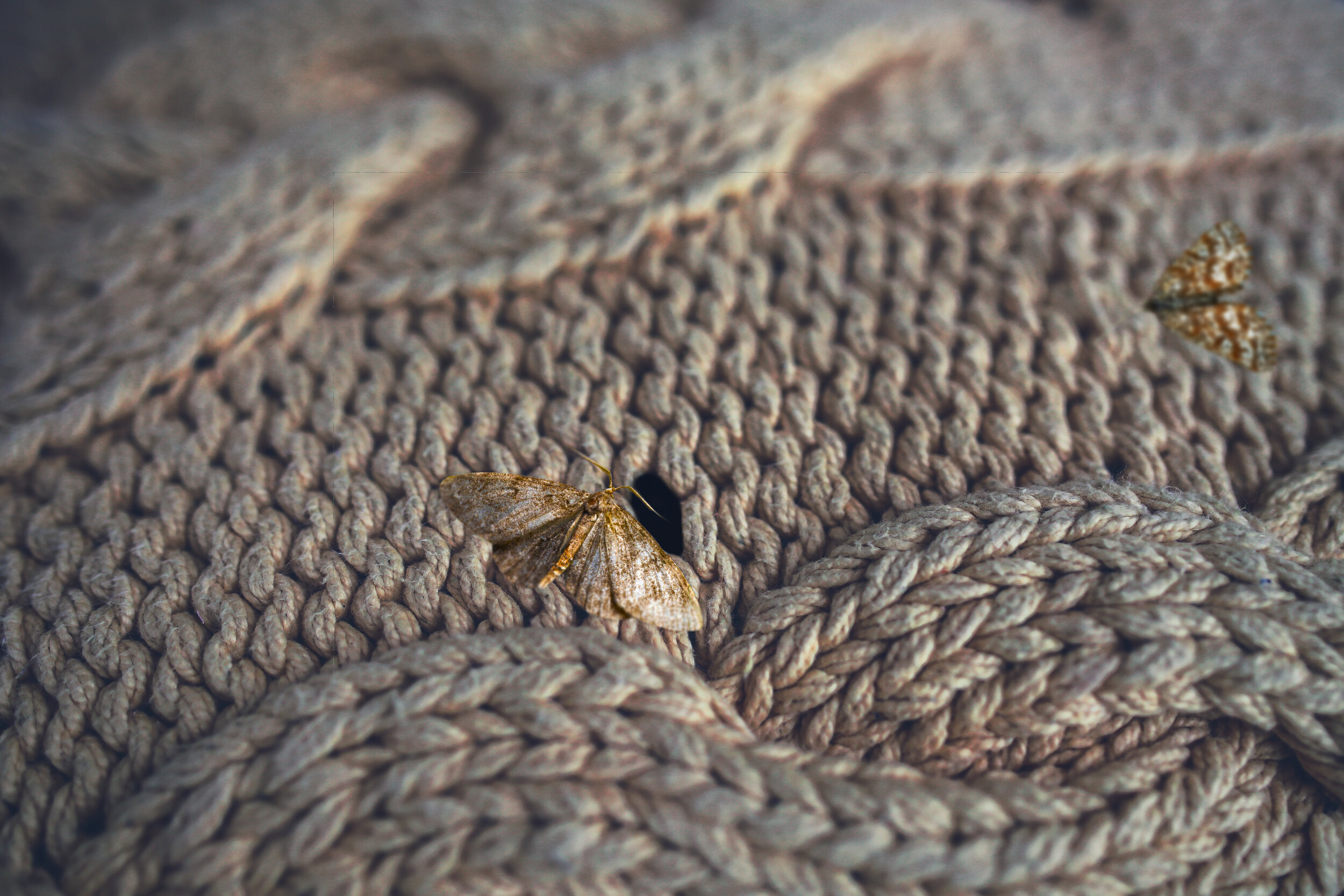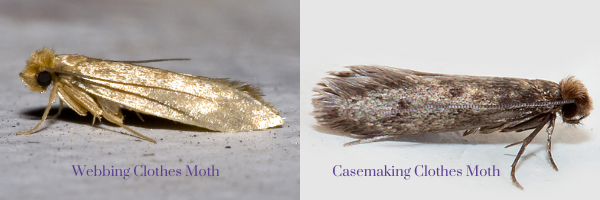what’s in your closet? Preventing moth holes
Just because you don’t see them doesn’t mean they’re not there. You might never see them flying around your home – they tend to camouflage themselves in tight, dark spaces. You could never even notice them at all… until you pull out your favorite sweater and find a gaping hole. That’s right, we’re talking about moths.
What’s the deal with moths? Why do they insist on munching on our best fabrics? How do we get rid of them? Let’s talk about these fuzzy annoyances destroying your favorite sweaters.
Why Do Moths Like Our Clothes?
Moths like dark, enclosed spaces, so closets and drawers are their ideal playgrounds. They also like natural fibers of animal origin, according to Cornell University’s Department of Entomology – like wool, cashmere, mohair, bristles, fur, feathers and silk. They’re attracted to oils, sweat, and food/drink stains, which is why holes are often seen more frequently on the fronts and sleeve-ends of garments. Even pet hair can attract them if it’s on your clothes in your closet. They lay their eggs within the fabric, and their larvae feed on the fibers. And thus, create holes. All that outdoor dining, home workouts, snuggles with your pups, and facial serums could be a factor in causing it.
The tragic irony of it all is that the nicer the clothing, the more likely it is to be hit by moths. That’s why it’s important to get rid of them as soon as you can
Take it from this guy that lost his closet...
Moths can go through clothing pretty quickly. According to Wirecutter by The New York Times, a Brooklynite lost five sweaters, two scarves, three ties, and spent $375 trying to protect himself against persistent moth damage. All in only three months. Moths can be tricky because they’re so hard to see. Especially in the summer when we’re not wearing our sweaters or scarves – moth holes can go entirely unnoticed. But, you’re smarter than that. Let’s talk about how to prevent these pesky insects.
How Do You Prevent Moths?
We’ve asked the best of the best – our Textile and Interior Teams at Meurice. Here’s the advice they had:
A good deep clean after a few wears could be a key in prevention. Dry cleaning your most valuable clothes regularly is the safest bet since moths are attracted to oils, sweat and food. Dry cleaning can kill moths, eggs and larvae without damaging the fibers (like high-heat washing or drying might). When designer Stella McCartney tells you to not wash your clothes, you might want to think twice. We know a really great dry cleaner, if you’re interested.
Pay attention to your closet and act at the first sign of any trouble.
Store woolens in well-lit areas – like a drawer you open often or on a shelf out in the open, because moths hate light.
During summer, store your sweaters, coats, scarves and hats in airtight containers or airtight plastic coverings.
Make sure to regularly vacuum dimly-lit, enclosed areas and corners (like closets or drawers) to get rid of lint that larvae may feed on.
Sift through your clothes often and take note of any damage or hints of infestation. Remember, these guys are masters at camouflage.
Along with the actual moths, keep a lookout for their tiny egg casings as well as their “silk” – cobweb-like, thin fibers that will sometimes be woven in with the clothing fabric.
What About the Actual Moths?
There are only two species of moths that harm your clothing, again according to Cornell’s Department of Entomology – the casemaking clothes moth and the webbing clothes moth (pictured below), and it’s their larvae that make the actual moth holes, not the moths. These moths are tiny, only about a centimeter in length. Any other type of moth in your home likely isn’t feeding on your clothes, but your plants. Let’s take a look at what they look like in case you see them:
Getting Rid Of Moths
Here’s the complicated part – you don’t have to call a pest service or use smelly mothballs, but you do have to take a lot of care to get rid of an infestation.
Your best bet is to call a dry cleaning service (you should know by now how this works!). Cleaning kills eggs and larvae, and specialized services can make sure the integrity of your clothing isn’t sacrificed.
Vacuum out essentially every inch your closet/drawers to the best of your ability. This is to make sure you suck up any larvae and eggs. Empty the vacuum in an outside trash can immediately.
You can also take any vulnerable animal-fiber clothing out of your closet and wash them on high heat. This will kill eggs, larvae and moths, but it may not be the best option for some clothing. Read the labels and consult an expert.
You can also dry them on high heat, but this also could adversely affect some clothing.
Then, you can freeze your clothing. This may not be as effective as heat, experts say, but it’s safer for expensive clothes. Put the clothes in a large plastic bag, then place in the freezer for at least 72 hours.
Mothballs should only be used as a last resort. Why? They’re strong pesticides, and can cause health issues if inhaled for long periods of time, and can seriously harm kids and pets if ingested. Also, they don’t smell too great, and the smell lingers in fabrics and closets. No one wants to smell like mothballs.
Takeaways
Just keep an eye out for moth holes, and don’t overreact with harsh chemicals or exterminators. Often, holes can be fixed if you catch the moths early. You can also give us a call if your clothes need some patching up. We’re pretty experienced in clothing restoration.
It’s easier to get rid of them than some other pests, so make sure you keep an eye on your high-quality clothes and schedule dry cleaning with us if you have any signs of unwelcome insects – meurice.nyc/experience-meurice.





